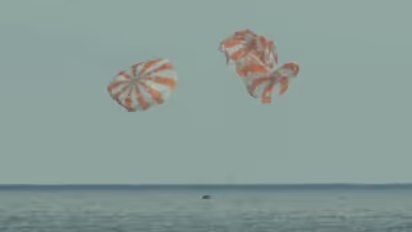Spalshdown! NASA's Orion capsule returns to Earth after 25-day lunar flight

Synopsis
NASA’s Orion capsule has splashed down in the Pacific Ocean after making an uncrewed voyage around the Moon, winding up the inaugural mission of the US space agency’s Artemis lunar programme 50 years to the day after Apollo’s final Moon landing.
After more than 25 days orbiting the Moon, NASA's newest manned spacecraft made its way back to the planet. The Orion spacecraft performed a fiery re-entry into Earth's atmosphere before splashing down in the Pacific Ocean. However, at later phases, parachutes were employed to stop the descent. The unmanned capsule was helped as it dropped to the ocean by three enormous red and orange parachutes.
As seen on NASA TV, the unmanned spacecraft travelled through the atmosphere at a speed of 25,000 mph (40,000 kph), then used three enormous red and orange parachute to fall to the ocean. NASA's landing and recovery director Melissa Jones remarked, "NASA, we had a picture-perfect splashdown."
Also Read | SpaceX's first private-funded Moon trip to include Indian actor Dev Joshi, K-pop star & others
Orion is the furthest habitable spacecraft to have ever left Earth, having travelled more than millions of kilometres around the satellite and returned. There weren't any passengers on board because it was only a test, but there will be for the actual thing. The Orion project at NASA will be rather complicated. It is anticipated that a mission to bring people back to the lunar surface would start in late 2024. As soon as 2025, two humans might make a manned lunar landing.
Also Read | Who is John McFall, the physically disabled surgeon in ESA’s class of 2022 astronauts?
Orion's safe return was NASA's top priority throughout the 25-day mission. The spacecraft carried a cutting-edge heat shield that had never been used in spaceflight before, enabling it to return to Earth far faster than it would have from low-Earth orbit at a speed of 25,000 mph (40,000 kph).
To reduce the gravity or G loads, it swiftly descended into the atmosphere and hopped out of it. This manoeuvre also made it possible to pinpoint the exact position of the splashdown.
Also Read | NASA's Orion spacecraft clicks stunning images of Moon, Earth; Check out